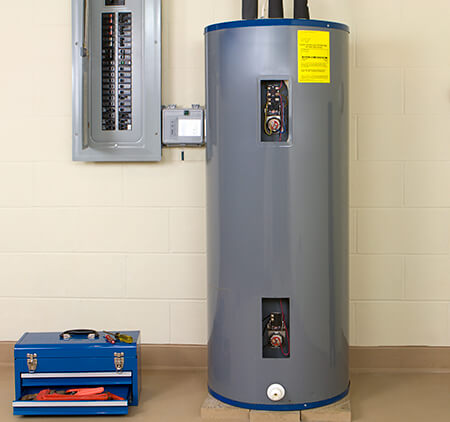Water heaters are the unsung heroes of every household. Without them, there is no hot water for showers, washing dishes, or washing clothes. Hot water is imperative to keeping your home functioning on a day-to-day basis. If you’re looking for a new hot water heater, you may wonder what’s the difference between a traditional water heater and a tankless system. This article will help you understand the difference and choose the model that’s right for you.
Traditional Water Heaters
Traditional water heaters work by heating and storing hot water in a tank. Depending on the demands of your home — the number of sinks and showers and the number of people in your home — the water heater tank can vary in size. A standard water heater typically holds around 50 gallons of water.
When you turn on a hot water tap in your home, the hot water is delivered from the top of the tank, while cold water comes in at the bottom. The water heater has two heating elements inside the tank that heat the cold water and allow it to rise to the top. This ensures that hot water is readily available when you want it.
When buying a traditional water heater, you may want to consult a plumber to decide what size you need. If you get a water heater that is too small for the needs of your home, you will likely run out of hot water quickly because the system can’t keep up with the demand. If your system is oversized, you will pay the price in extra utility bills.
Tankless Water Heaters
A tankless water heater works differently than a traditional water heater. First, there’s no tank. Instead, the system works by an on-demand system. When you turn on a hot water faucet, a signal is sent to the heating element within the tankless system to start. A coil heats water as the plumbing line wraps around it and instantly heats the water as needed. When you turn off the hot water faucet, the heating element cools down until hot water is needed again.
Traditional Water Heaters: the Good, the Bad, and the Ugly
The good thing about traditional water heaters is that they store hot water and consistently keep the tank hot. If your system is not supplying enough hot water for your needs, you may be able to simply turn up the temperature on your water heater. This will probably increase your energy bill. Likewise, if your water is scalding hot, you can lower the temperature of the tank, which also lowers the utility bill and could lengthen the lifespan of the system.
The bad things about a traditional water heater are the space it takes up and the maintenance required for optimal performance. You can usually find your water heater in a basement, utility room, or crawl space. These tanks take up a significant amount of space, which can be a problem in smaller homes. Placing them in a crawl space or unconditioned room makes them work harder to maintain temperature, which shortens the system’s lifespan.
Traditional water heaters also require a flush-out at least once a year. This requires an experienced plumber to drain the water completely from the tank. The purpose of this is to flush out the sediment that has settled into the tank from the intake of water. Over time, this sediment builds up and reduces the amount of space for storing hot water.
The ugly part of owning a traditional water heater happens when a system is old and/or neglected. Inside your tank is a sacrificial rod called an anode rod. The anode rod is designed to protect the metal parts inside the water heater from corrosion. When the tank is not flushed on a routine basis, the sacrificial rod corrodes, your heating elements begin corroding. This will also happen when your tank is past its recommended lifespan. Once this happens, the system will never perform at optimal capacity, and it’s time for a new system.
Tankless Water Heaters: the Good, the Bad, and the Ugly
The good thing about tankless water heaters is that the technology has developed to make them efficient and reliable, which is why they have become popular in recent years. They save energy because they are not constantly heating water that is not being used. They save space because they can be mounted to a wall in line with your distribution lines. These systems have digital thermometers to monitor the temperature of the water, which can be easily adjusted.
The bad thing about tankless water heaters is something called “the sandwich effect.” This refers to the gap in the hot water supply between when you turn on the hot water and when the heating element engages. Much like traditional water heaters, you will have a few moments of cold water coming through the faucet before it gets hot. Occasionally, the system will not be able to keep the continuous supply of hot water, and you may experience a jolt of cold water before hot water returns. This is usually a sign of an undersized system.
The ugly part of a tankless system occurs when an undersized system is installed in your home. Let’s say you live by yourself in a two-bathroom home. Your system is designed to provide you with enough hot water to shower, do laundry, and run the dishwasher. Now, your family comes to visit, and all of a sudden, two showers are running simultaneously with the dishwasher and washing machine. Your system may be unable to keep up, leaving someone in the shower with cold water.
Avoid tankless water heater issues by using a licensed plumber to install a properly sized tankless system in your home.
What’s Best for Your Home?
As you have seen, there are benefits to both systems. The traditional water heater system can supply plenty of hot water for a large family as long as it is properly sized. However, the amount of use and the routine maintenance required need to be considered before installing a system.
Likewise, a tankless system can also supply enough hot water for a large family, but sizing is key. You may need to install more than one tankless water heater to allow all appliances and bathrooms the required amount of hot water.
The key to making a decision boils down to your daily requirements for hot water, the size of your household, and the number of people within the home. While tankless systems can be more energy efficient, they can lose some efficiency when multiple tankless heaters need to be installed. However, traditional water heaters waste energy when you are not regularly using hot water. These are a few things to consider when consulting with a professional plumber.
The Safe Bet
The best thing you can do when deciding on your next water heating system is to consult a professional, licensed plumber. Sun City Mechanical has provided the residents of Sun City with high-quality installation and maintenance of water heaters since 2003. We also install, repair, and maintain heating and cooling systems as well as offer indoor air quality services.
Our experienced plumbers help you make the best decision for your home and ensure a quality installation. Call Sun City Mechanical today, and speak with our knowledgeable technicians about all of your plumbing, heating, and cooling needs.

